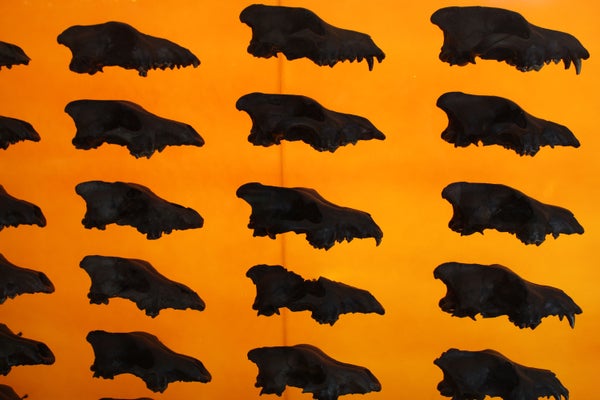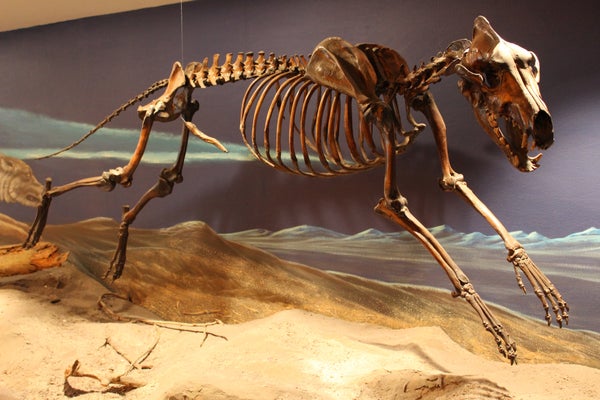This article was published in Scientific American’s former blog network and reflects the views of the author, not necessarily those of Scientific American
Everyone has their own characters to root for in Game of Thrones. There's no shortage of heroes and social climbers to pick for a favorite, but, as the blood-soaked seasons have wound on, I've been sorry to see my favorites killed off one by one. In Westeros, direwolves are the real underdogs, facing down the same extinction that they suffered in the real world.
George R.R. Martin's canids are a curious breed. The beasts are enormous, with some rumored to reach the size of ponies, and they're also part of the novelist's Pleistocene pastiche. Along with woolly mammoths, direwolves are creatures that really lived on Earth not so very long ago. And while Game of Thrones has largely neglected these poor pups, paleontologists have been able to dig up quite a bit about the lives of the Ice Age pack hunters that used to pad around North America.
If you were able to wander around the Ice Age Americas between 125,000 and 10,000 years ago, you would have been able to hear the howls of dire wolves almost everywhere you went. Their bones have been found from southern Alberta, Canada all the way down to Bolivia at elevations from sea level up to 7,400 feet. In the what would become the United States, they loped from coast to coast, although the hundreds upon hundreds of specimens drawn from the La Brea asphalt seeps in southern California puts all other collections to shame.
All these remains reassemble into an animal that wouldn't have been quite so imposing as Lady, Ghost and the other fictional canids in George R.R. Martin's world. Canis dirus were larger and more burly than the gray wolves that were also slinking around during the Pleistocene, with an estimated average weight of 130 pounds compared to 88 for gray wolves. That's hefty, but nowhere near horse size. In fact, telling a living dire wolf apart from a gray wolf might have been difficult without looking them both in the mouth. Among other dental differences, dire wolf jaws have a very large first molar shaped to give them a better shearing bite than their relatives.

A small sample of the many dire wolves found at the La Brea asphalt seeps. Photo by Brian Switek.
Still, despite the anatomical points that mark them as a different species, dire wolves probably lived much like the gray wolves that still lope around parts of North America. The sheer number of remains found at the La Brea asphalt seeps, outnumbering any other large vertebrate by far, only make sense if dire wolves were pack hunters, which falls into accord with evidence that these carnivores were chasing mid-sized herbivores such as horses. Wolves lack the grappling abilities of cats, relying instead on their running endurance and jaws, and so the dire wolf has almost always been envisioned as roving through prehistoric habitats in packs. More than that, some dire wolf remains at La Brea show painful injuries that would have crippled the animals and yet show signs of healing. This hints that these dogs had some sort of social support structure that allowed them to survive.
On supporting science journalism
If you're enjoying this article, consider supporting our award-winning journalism by subscribing. By purchasing a subscription you are helping to ensure the future of impactful stories about the discoveries and ideas shaping our world today.
Dire wolf teeth and jaws do more than just fill in details about their hunting lives, though. Male and female dire wolves have similarly-sized canine teeth, for example, suggesting that dire wolves formed pair bonds with mates instead of males vying for dominance. And teeth also record tough times for dire wolves. About 15,000 years ago, the dire wolves of La Brea were chewing bone more often. Fractured teeth suggest that dire wolves really had to make the most of every carcass. Better times came back by about 12,000 years ago, although the very last of these carnivores disappeared just after 10,000 years ago. Exactly why we can't find them still loping around the Americas today is a mystery.
"There’s not been a direwolf sighted south of the Wall in two hundred years." This is what Theon Greyjoy says when Robb Stark discovers a litter of six pups, helpless after the death of their mother, at the very beginning of Game of Thrones. It seems that the series is moving towards extirpating them all over again, repeating the slip of extinction that their real counterparts suffered. But, according to the lore, there are wolves still north of the Wall, and winter is coming. I hope the direwolves come with it.
References:
Anyonge, W., Baker, A. 2006. Craniofacial morphology and feeding behavior in Canis dirus, the extinct Pleistocene dire wolf. Journal of Zoology. doi: 10.1111/j.1469-7998.2006.00043.x
Anyonge, W., Roman, C. 2006. New body mass estimates for Canis dirus, the extinct Pleistocene wolf. Journal of Vertebrate Paleontology. doi: 10.1671/0272-4634(2006)26[209:NBMEFC]2.0.CO;2
Binder, W., Thompson, E., Van Valkenburgh, B. 2002. Temporal variation in tooth fracture among Rancho La Brea dire wolves. Journal of Vertebrate Paleontology. doi: 10.1671/0272-4634(2002)022[0423:TVITFA]2.0.CO;2
Dundas, R. 1999. Quaternary records of the dire wolf, Canis dirus, in North and South America. Boreas. doi: 10.1111/j.1502-3885.1999.tb00227.x
Harris, J. 2010. Rancho La Brea: Death Trap and Treasure Trove. Los Angeles: Natural History Museum of Los Angeles County.
Van Valkenburgh, B., Sacco, T. 2002. Sexual dimorphism, social behavior, and intrasexual competition in large Pleistocene carnivores. Journal of Vertebrate Paleontology. doi: 10.1671/0272-4634(2002)022[0164:SDSBAI]2.0.CO;2
